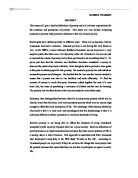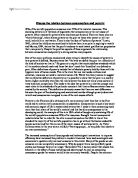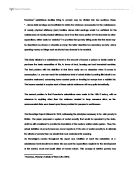Some of the statistics discovered are as follows :
- 9.5 million people cannot afford to heat their homes properly
- 8 million cannot afford essential household goods, ie refrigerator, carpets etc
- 4 million are not fed adequately, ie with fresh fruit and vegetables
- 6.5 million are without essential clothing, ie warm waterproof
- 34% of children are without one or more essential living items such as appropriate clothing, healthy dietary requirements, and items for educational development and social activities.
That is 1 in 50 children suffering the effects of poverty. The highest rates were found in homes of adult unemployment, part-time employment, lone parent households, disabled and sick families, ethnic minorities and large families (Press Room Release. Monday 11 September 2000 ).
A statement by Sue Middleton, one of the analysts of the survey, declared “Some of Britain’s children are going without items which are widely accepted as being vital to the health and development of children.” (Middleton 2000)
There is also evidence of widespread poverty in older people, many of whose working lives have produced reasonable earnings which allowed for an independently achieved standard of living. Upon retirement, they experience a dramatic reduction of income, which over time plummets their standard of living down to poverty terms. British pensioners are the largest group of people receiving means-tested benefits. 1.3 million were solely dependent on state pensions in 1998 (Howarth et al 1999). (Giddens 2001:316)
Research in the 1990s showed alarmingly high rates of poverty within UK Pakistani and Bangladeshi families where unemployment was particularly high. It was estimated that ethnic minority families were four times more likely to be living on low incomes than white households. A study by Richard Berthoud (1998) from Essex University gathered in depth information from 2,500 ethnic minority households. His findings revealed some key issues, which are as follows :
- Unemployment in men, lack of working women, low pay and large families are contributing factors to the situation, leading to 60% of households being below the poverty line.
- The equivalent in white households with less than half the average income is 16%
- High levels of employment in Indian and Chinese families bring their average earnings to more than that of white families. Yet their poverty rates, at 22% and 28% respectively, still remain higher than white households.
- There is only a slightly higher proportion of Caribbean families in comparison to white families living on half the national income.
- 31% of African origin are living below the poverty line.
“The extent of poverty that this study has revealed among Pakistani and Bangladeshi origin is striking and demands greater attention from policy makers. Lack of appropriate education and training provides part of the explanation and could be part of the solution.” (Berthoud 1998)
He adds that “Means tested benefits are designed to maintain families at a minimum income without wasting public money, but they also create a sense of dependence on the state.” (Berthoud 1998) (Press Room Release, Monday 23 November 1998. )
This reasoning has created various forms of explanations as to why poverty persists in society today. Many influential people in the field of sociology and politics have argued as to why this may be. Some of the credible explanations are as follows :
The ‘dependency based’ explanation describes poverty as a result of individual and cultural deficiencies. It includes the belief that a certain section of the population ‘do not’ want to work, namely ‘the underclass’. As was expressed by Mansland (1996), ‘A generous welfare system has destroyed the will to work.’ This in turn has created a generation of state-dependent families, whose values have been passed from generation to generation.
This argument of the ‘underclass’ was first developed by American writer Charles Murray (1990) after conducting a race-based study in the USA. He believed the ‘underclass’ to be the bottom rung of a class-stratified ladder within modern day societies. He argues that these people prefer to live off state handouts because they are too lazy to work and have no will to look after themselves.
He also accepted the argument that some people were poor through no fault of their own, but insisted that “the bulk of poverty is caused by those who do not make the effort to earn a living, and/or waste what they do have.” (Murray 1990) (Moore et al 2001:141).
Murray’s (1989) analysis of the ‘British underclass’ differed from his American study which had been targeted towards the Afro-American residents. His British study was not race-based, but he depicted that a clearly defined underclass was not yet in existence although one was rapidly developing and would not only include ‘members of ethnic minorities, but whites from impoverished areas where social disintegration was advancing.’ (Giddens 2001: 322)
He went on to argue that the underclass made themselves identifiable through the existence of certain characteristics they possessed. These caused an impact on society, which in turn defined their position within the class structure of society.
In an article for the British ‘Sunday Times’, he wrote “Poor people were defined by their behaviour. Their homes were littered and unkempt. The men in the family were unable to hold a job for more than a few weeks at a time. Drunkenness was common. The children grew up ill-schooled and ill-behaved and contributed a disproportionate share to the local juvenile delinquents.” (Murray 1989)
He believed that the increase in crime, illegitimacy, high levels of unemployment and benefit cheats would create the ‘British underclass’.
Upon his return to Britain in 1993, Charles Murray’s analysis of British societies had fulfilled his predictions. There was a noted 42% increase in property crime; 40% increase in violent crime; the rate of unemployment in Britain was only slightly different and illegitimacy had risen to 31.2%. With these results, he concluded “the England in which the family has effectively collapsed does not consist just of ‘blacks’, or even the inner-city neighbourhoods, but lower-working class communities everywhere.” (Murray 1994)
Murray’s arguments have been severely criticised by many colleagues studying the field of sociology. A vast amount of surveys have been carried out which raised doubts about his claims. Many believe Murray to be wrong to argue that those people reliant on state benefits are less willing to work than others. Anthony Health (1990) conducted a study of people of working age. He compared his results between those in employment and those not and found that 86% of the unemployed wanted to work, against 57% of those with at least one family member working.
Another study which undermined Murray’s claims was conducted by Alan Walker (1990) who refers to the findings of Brown and Madge (1982) who investigated Sir Keith Joseph’s claim of a ‘cycle of disadvantage’. They discovered that “50% of those born in a disadvantaged home did not end up disadvantaged themselves.” (Brown & Madge 1982) (Haralambos and Holborn 2001: 326).
The second explanation as to why ‘poverty persists’ is known as the ‘exclusion based’ argument. Social exclusion is the result of inequality within society. This approach stresses the differences between those with power and those who are poor. It is argued that the poor are poor because they do not have the same opportunities as the more powerful in society and are therefore unable to achieve a reasonable standard of living.
The Government defines social exclusion as “What can happen when people or areas suffer from a combination of linked problems such as unemployment, poor skills, low income, poor housing, high crime, bad health and family breakdown.” (David Batty. – Tuesday 15 January 2002)
The most powerless groups in society today tend to be the disabled, older people, women, ethnic minorities and children, all of whom are more likely to be living in poverty than the rest of society.
If any of the aforementioned groups were to find employment, they would undoubtedly be subjected to short-term, low-paid, temporary and possibly ‘unofficial’ work (Moore et al 2001: 143).
A minister of the Labour Government and poverty campaigner, Frank Field MP (1998), although in agreement with Charles Murray !1998) regarding the advancing underclass in British societies, viewed its existence a great deal more sympathetically than his American counterpart. He considered the ‘underclass’ to be blameless victims of government policy and social change. He linked the growth to the reduction of citizenship rights which had adversely affected the most vulnerable within society.
He claimed that since 1979 “the 300-year-old evolution of citizenship as an incorporating force in British society has been thrown in reverse.” (Field 1998) (Haralambos et al and Holborn,2001:328). He believed this to be the turning point of social citizenship which denied equality to all.
It was the belief of Field (1998) that there were three groups of individuals who were severely hit by the changing government policies. They were namely the long-term unemployed; lone-parent families; and pensioners, all of whom were largely dependent on state benefits alone. They, due to their circumstances, became helpless victims of social exclusion because their income did not generate enough wealth to permit a reasonable standard of living.
Recently Frank Field MP has campaigned for a complete overhaul of the British welfare system.
Politicians of Britain are now beginning to recognise the term ‘social exclusion’ and are focusing on it much more sympathetically than they originally did. It is being gradually accepted that to live a full and healthy life, we must all be able to access essential goods and social services within our communities. It is extremely important for all members of society to have equality in the use of education, healthcare and public amenities such as transport and banking services.
In this day and age, with one in five adults living in households with less than 60% of the median wage, and almost 4 million children living below the breadline, we must question what can be done to improve the lives of so many who literally just exist through harrowing hardship.
Again, this is an area which has inspired considerable debate which, as ever, has produced many valid points and numerous valid criticisms.
Britain has provided welfare provisions since the findings of the Beveridge Report (1942), in which he Beveridge outlined the existence of ‘5 social evils’ which he felt the government had to eliminate. He found these to be poverty, ignorance, disease, squalor and idleness.
The creation of Unemployment and Sickness Benefit for those capable of work, Income Support for those unable to work, free schooling until the age of 15, a National Health Service for all, house building initiatives in which the Labour Government of that time planned to build 4 million homes in a decade, and a promise to ensure that mass unemployment became a thing of the past, were all produced as a result of the Beveridge Report (1942) and all comprise the British welfare system.
However, welfare has been criticised by the ‘New Right’ approach to the solution of poverty. It blames the Welfare State for direct and indirect causes of poverty. The argument here is that the majority of government spending is on welfare provision. This produces high levels of taxation which in turn discourages entrepreneurs and businessmen from investing in British industry. This then leads to a lack of employment opportunities for the general public and increases the amount of spending for welfare benefits. The result is a vicious, unending circle of indirect poverty.
The New Right’s direct argument in the cause of poverty looks at the thoughts of Charles Murray (1989) in which they agree that the existence of the welfare system produces a subculture of individuals who lose the will to work and support themselves because they know that they will be subsidised by appropriate benefit payments.
The New Right also believed it to be important for the wealthier to succeed as this success will filter down to the poorer groups, therefore eliminating, or at least reducing, poverty by generating more employment.
This approach has been tried and tested in the USA with no evidence of success. In fact, the opposite has occurred. Poverty in America has grown, not eased.
In a rather sexist report from Charles Murray (1994), he suggested that a viable solution to poverty would be to return the benefit system to the 1960 era by eliminating benefits for unmarried women, who would then have to avoid pregnancy outwith marriage or they would be penalised by the lack of economic support. This idea was to encourage marriage and nuclear family ideals, but to blame the women in society and to take away their independence is ridiculous in the extreme.
Not surprisingly, this suggestion has had a huge array of criticisms. There have been extensive studies carried out by influential people who have produced results which extremely weaken Murray’s (1994) claims of the New Right perspective.
Some of the many who disagree with the New Right approach are the Social Democratic supporters. According to this group the role of the welfare system is to provide those who, through no fault of their own, are in poverty with a decent standard of living. These may be disabled, retired or those with childcare responsibilities who are unable to work for obvious unfortunate reasons.
A point raised about the welfare system is that it has not really moved with the times. Mack and Lansley (1985) claimed that raising the benefit level by 150 per cent of its then level would ‘solve’ the problem of poverty. They concluded “People need to accept that the problems of the poor should be tackled, and that the state has a responsibility to tackle them.” (Mack and Lansley, 1985). They also found that 74% of the public would accept a penny in the pound increase in income tax in order to help the poor (Haralambos and Holborn 2001: 344)
In connection with this view, and in sympathising with the reality of high taxation discouraging investment, Peter Townsend (1997) suggested that an ‘international welfare system’ operated in all industrialised societies, would maintain government spending to a level which would not discourage investment in any of the industrious areas, and if limits were laid on wealth and earnings this could allow for adequate benefit payments for the unemployed. Also, individual governments would benefit from the progress of globalisation equally, if taxation were the same worldwide. This may seem a very radical view, but Britain’s adoption of the Euro may be the first stepping stone in achieving this kind of economic change.
The final approach I want to examine is that of the ‘Third Way’ which the Labour administrations have implemented. It has taken into consideration all the valid points and numerous criticism surrounding all the other approaches to a solution. This group feels their way of combating poverty will be the most viable and successful in the history of Government since the welfare system was introduced in the 1940s.
It is their plan to encourage more people into employment by initiating incentives such as childcare provision and training programmes for the young and the long-term unemployed. They believe that when in full-time employment people will benefit from wage levels adequate to raise them out of poverty. To ensure this, a minimum wage has been introduced in Britain.
The main aim of the Third Way is to focus on the effects and causes of social exclusion, which as was discussed earlier has been linked to poor health, antisocial behaviour and school failure. It is the promise of today’s Labour leadership to create a range of programmes to eliminate all of these disadvantages. The introduction of the Social Exclusion Unit is designed to reintegrate the public and evoke a harmonious society.
This approach may initially seem to be the most sensible and straightforward, but has every government not promised employment opportunities for the masses? And all have failed miserably Also, in order for a minimum wage to succeed it has to be of a fair amount. Can people be raised from the benefit backing on which they are still reliant with an income of only £3.70 an hour?
In conclusion, I feel it is important to recognise the severity of this problem as it is one which affects us all, tax payers and non-tax payers alike.
Today’s government under the leadership of Tony Blair has so far made some hopeful changes to the employed sector of the population with the formation of the minimum wage, which has helped close gender pay differences that have been an issue for over 40 years. Also, it has backed the use of worthwhile incentives to encourage single parents and the long-term unemployed back into the workforce, and has promised to eliminate child poverty within 20 years of their control.
Perhaps there is an end in sight. Labour’s promise to the people does ignite a certain degree of excitement. Their proposals sound encouraging but there remains a shadow of doubt on the way these new approaches are being initiated. The use of heavy-handed recrimination for those who are struggling with training schemes or refusing unsuitable employment offers is counter-productive. Benefit suspension seems a rather bully-boy tactic and will certainly not do anything to close the poverty gap.
Think again, Tony!
BIBLIOGRAPHY
Sociology 4th Edition
Anthony Giddens, 2001. Polity Press
Sociology for AS Level
Stephen Moore; Steve Chapman; Dave Aiken, 2001. Collins Educational
Sociology Themes and Perspectives
Haralambros and Holborn, 2001. Collins Educational
Despite The Welfare State
Muriel Brown and Nicola Madge, 1982. Heinmann Educational Books Ltd
The Evolution of the British Welfare State
Derek Fraser, 1973. Macmillan Press Ltd
Encyclopaedia Britannica 1994-2000 CD Rom
3762 words inc biblio







